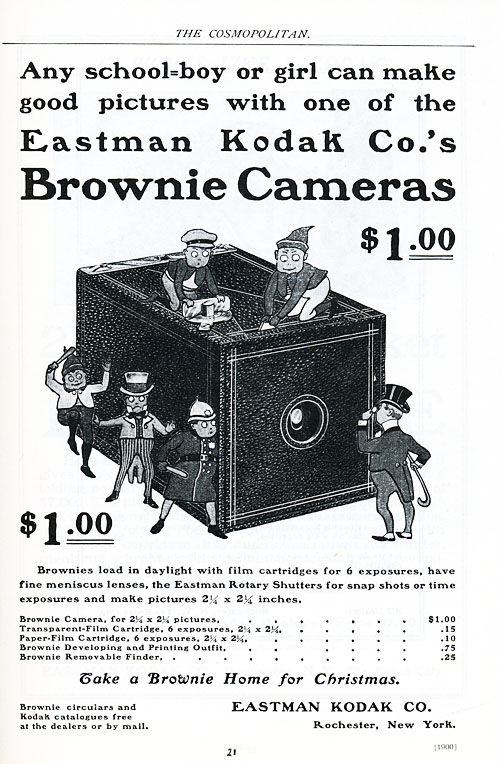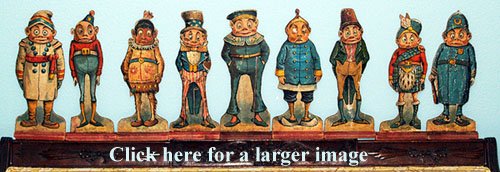Brownie Cameras
Today, cameras and sprites. The University of Houston's College of Engineering presents this series about the machines that make our civilization run, and the people whose ingenuity created them.
We have nine flat wooden figures in our attic -- comic charicatures about a foot high. They're odd beings with round faces and spindly legs -- an Indian, a sailor, a Chinese, a policeman ... They were my father's toys when he was a toddler and they bear an 1892 copyright by Palmer Cox. These are the so-called Brownies.
 Brownies were a kind of sprite in Scottish legends. Little people who came out at night. They cleaned and fixed up households -- unless they'd been offended. Then they did mischief. In the 1880's, the Canadian Cox began writing about brownies and he created those brownie images. He turned the old legends into children's stories. His brownies reflected the new evolving democratic political systems. They were completely individual -- no two alike. And they worked together without leaders.
Brownies were a kind of sprite in Scottish legends. Little people who came out at night. They cleaned and fixed up households -- unless they'd been offended. Then they did mischief. In the 1880's, the Canadian Cox began writing about brownies and he created those brownie images. He turned the old legends into children's stories. His brownies reflected the new evolving democratic political systems. They were completely individual -- no two alike. And they worked together without leaders.
They were also daring technologists. In one story, Cox has them finding a hot air balloon, fallen in the forest. The brownies repair it, fill it with gas, and rise into the sky. We read,
Said one: "As smoothly as a kite,
We'll rise above the clouds to-night,
And may the question settle soon,
About the surface of the moon."
Now an article by one Marc Olivier tells how, on the heels of the Brownie craze, the Eastman Kodak company made brownies into a powerful metaphor. Late 19th-century photography was a gentleman's hobby, and it took a lot of skill. Eastman had been trying make photography available to all. His original 1888 Kodak camera had come preloaded with a hundred shots. You mailed the camera back to the factory to get the film processed.
In 1900, Eastman went a step further. He made a very simple box camera and sold it for a dollar. It had a fixed lens, used commercial roll film, and required almost no skill or special equipment. What to call such a camera? Well, the word Brownie embodied Eastman's idea. Beyond being cute, Cox's brownies practiced what Eastman believed about technology.
Eastman's media blitz made the connection very clear. The first ads showed brownies swarming over the camera -- made of wood and cardboard, with a fake black-leather finish. This was indeed something they might use. If Cox had them flying their own balloon, Eastman now made photographers of them. For technology was then, and always has been, the soul of democracy.
When I was a child, my photojournalist father (his toys now in the attic) had taken up the big Speed Graphic camera. But Brownie cameras endured. My mother used hers to capture us kids. Eastman was still making them in 1967.
An earlier time comes back in a rush as I read Olivier's article with those wooden figures at hand. This had been the age when, like no other, technology leveled the human playing field. It worked for us then. And I dearly hope we continue to make it work for us -- in our far murkier and more complex world.
I'm John Lienhard, at the University of Houston, where we're interested in the way inventive minds work.
M. Olivier, George Eastman's Modern Stone-Age Family: Snapshot Photography and the Brownie. Technology and Culture, Vol 48, No. 1, pp. 1-19.
P. Cox, The Brownies: Their Book. (New York: Century Co., 1887. Reprinted by Dover, 1964). (Cox's photo above is in the public domain. Brownie photos by JHL.)
For enlarged brownie images click on: Uncle Sam and Indian or Bellboy and Irishman.

One of the earliest Brownie camera advertisements with brownies.
